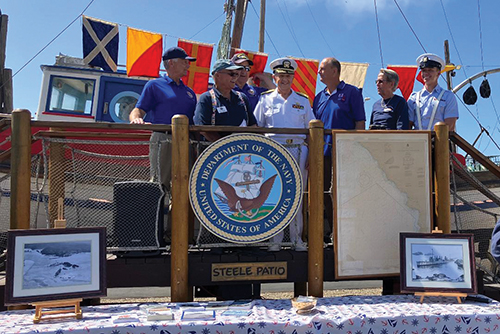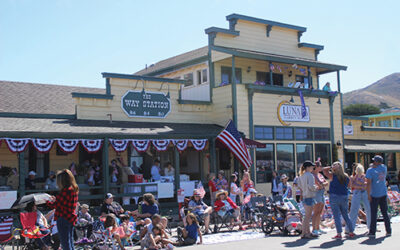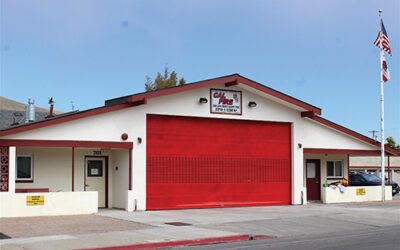Pictured are Steve David, U.S. Navy (retired); Scott Mather, MBMM past president and MC for program; Chuck Belmont, U.S. Navy Vice-Admiral Bill Bowes, (retired); Lt. Col. Erik Brun, (retired) curator with the Camp San Luis Military Museum; Dave Thomas, owner of The Shell Shop of Morro Bay and son of Lawrence Thomas, who with Dean Tyler and Ernie Porter received authorization to selvage artifacts off the downed destroyers, including the bell off the USS Young; and U.S. Coast Guard BM-3 Garrett, who presented the colors opening the program with a salute and thank you to all veterans for their service. Photo by Judy Salamacha
By Scott Mather
On September 8, 1923, the US Navy Destroyer Squadron Eleven were performing an exercise that simulated wartime conditions. The goal was to make fast passage from San Francisco to San Diego, so the decision was made to not slow down despite the heavy fog encountered off the Central Coast. All ships were ordered to travel in close formation and, turning too soon, hit the rocks. Seven destroyers sank. Twenty-three sailors died.

Photo by Judy Salamacha
Now remembered as Honda Point, the site is off Point Arguello, on the rocky seacoast near US Space Force and Lompoc, CA. Still known today as the United States Navy worst peace time disaster on record.
On Sunday, September 10, Morro Bay Maritime Museum collaborated with several agencies to commemorate the 100th Anniversary and recognize the brave sailors lost.
The 23 sailors lost and recognized were James W. H. Conway, James T. Pearson and Sofornia Dalida off the USS Delphy and from the USS Young the Ralph K. Buchanan, Clitus A. Reddock, Enrique Torres, Ernest C. Harrison, Edward C. Kirby, Vern R. Van Shaak, Hugh W. Skipper, August Zakrewski, John Young, Henry T. Kirk, Max H. Taylor, Charles A. Salzer, Ernest Johns, James T. Martin, Everett W. Grady, Gordon J. Overshiner, Earl Duncan, Joseph J. Slimak, Wade H. Morris, Leo F. Rogers.



